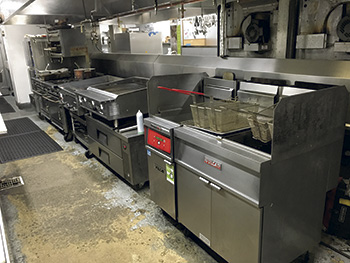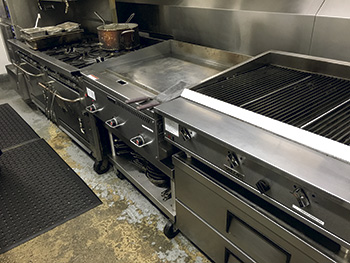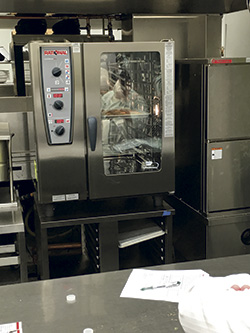The DoubleTree Hotel in Pleasanton, Calif., is the latest participant in the Comprehensive Commercial Kitchen Equipment Retrofit (aka, “the cookline project”), a grant project awarded by the California Energy Commission to the PG&E Food Service Technology Center (FSTC) in San Ramon, Calif. As part of the project, the FSTC teamed up with the Southern California Gas Co. (SoCalGas) and San Diego Gas & Electric (SDG&E) to study various foodservice operations in a demonstration of high-efficiency commercial cooking equipment and kitchen system optimization in commercial foodservice.
Part of the cookline project involves establishing a baseline with older, less efficient equipment existing in the kitchen and then replacing those pieces with Energy Star models to determine resulting energy savings (and, if applicable, water savings). Previous participants in the study have included Werewolf Bar & Grill in San Diego and Gate Gourmet, the large-scale caterer for major commercial airlines. In both cases, the operators were able to note marked energy and even water savings as a result of the equipment line replacements, resulting in thousands of dollars saved.
At the DoubleTree Hotel, PG&E virtually replaced the kitchen’s full line, including a griddle, fryer, broiler, double-stack convection oven and three steamers. Everything was a one-for-one replacement, except for the three outdated steamers, which were replaced by one efficient steamer and one combi oven.
Preliminary measurements show the hotel is reducing energy use by up to 30 percent for each of the replacement pieces, which by the end of the year should account for hefty savings — hundreds, even thousands, of dollars. The hotel is also saving a tremendous amount of water, thanks to changes with the steamers. This is particularly important in California, where water and sewer prices continue to skyrocket.
The Broiler
For the broiler, the DoubleTree Hotel downsized from a 4-by-3-foot model to a 3-by-3-foot infrared Energy Star-rated model, resulting in a savings of about 30 percent to 40 percent.
“Initially, [DoubleTree staff] were having trouble with the new broiler because they were operating it at the same high level as the old one, and this caused the broiler to scorch the food and create a lot of smoke,” says Denis Livchak, energy testing lab manager at the PG&E Food Service Technology Center. “Once they adjusted the levels on the broiler, they were able to cook the food effectively using much less power and energy.”
The Fryer
 Previously, the equipment in DoubleTree Pleasanton’s main kitchen included an old double-vat fryer that used 3.7 therms per day with a pilot light for each fryer left on 24 hours a day, 7 days a week.
Previously, the equipment in DoubleTree Pleasanton’s main kitchen included an old double-vat fryer that used 3.7 therms per day with a pilot light for each fryer left on 24 hours a day, 7 days a week.
The new, energy-efficient replacement fryer with a power burner and five-pass heat exchanger also features electronic ignition to prevent additional energy usage. In this case, the heat-exchanger system on the fryer heats the oil more directly around the sides, rather than from the bottom of the fry pot, as the older model did. These features resulted in a 30 percent savings, with energy usage reduced by 2.6 therms per day, according to preliminary measurements provided by Livchak.
In addition to saving energy, the new fryers also help maintain oil quality, which should reduce how frequently the operator must change the oil, according to Livchak. “Inefficient, older-model fryers tend to scorch the oil at higher temperatures, which makes the oil darken faster and require more frequent replacement.” New fryer models also feature more state-of-the-art filtering mechanisms.
The Griddle
 The DoubleTree cookline now features a griddle with thermostatic controls that help control energy consumption.Prior to the replacement, this DoubleTree location had a non-thermostatic, low-input 3-foot griddle with manual adjustments and no temperature feedback, used primarily for breakfast items. The new energy-efficient griddle uses 2.9 therms per day, versus 4.1 therms per day, for an energy savings of 30 percent, according to Livchak.
The DoubleTree cookline now features a griddle with thermostatic controls that help control energy consumption.Prior to the replacement, this DoubleTree location had a non-thermostatic, low-input 3-foot griddle with manual adjustments and no temperature feedback, used primarily for breakfast items. The new energy-efficient griddle uses 2.9 therms per day, versus 4.1 therms per day, for an energy savings of 30 percent, according to Livchak.
The new griddle saves energy through thermostatic controls and automatic ignition, reducing a standing pilot. Initial operator responses have been positive; users enjoy the enhanced consistency and temperature uniformity of the unit. This particular griddle also has three built-in thermostats in case the user wants to use one portion of the griddle for cooking and another for warming. There’s also no need to turn all the burners on at once, thus saving more energy over time.
Replacing the old griddle also saved catering redundancies and space; previously, the griddle featured an undercounter convection oven that was used only for storage. Instead, the new griddle was outfitted with shelving to hold pans and other equipment more efficiently.
“That’s a whole other story,” Livchak says. “How many restaurants actually use the ovens underneath their ranges? Those ovens typically are very inefficient, and if they are used, they can use more energy than even a larger-size convection oven.”
The Steamers
The three older steamers presented a unique challenge. The operator primarily used only one of the three on a regular basis and two in the case of large banquets. Often, one of the steamers was used just for storage.
Still, it cost DoubleTree an estimated $2,000 dollars per year in water costs just to run the one 300-gallon steamer, according to Livchak. The steamer that used the least water — 80 gallons — was not even used on a daily basis, and it had a leak.
By replacing the old steamers with the new steamer, which uses about 35 gallons, and combi oven, the hotel was able to save an estimated 250 to 350 gallons per day.
Older, less efficient steamers use cold water to cool down the 200-plus degree condensate water because most municipalities require water going down the drain to be 140 degrees or less. “A large portion of the water consumption is not even going to steam the food, but rather, down the drain,” says Livchak. That equates to thousands of dollars a year — also down the drain.
Newer, energy-efficient steamers not only use less water to cook the food, they use considerably less water to cool down the condensate. Most Energy Star-rated steamers are boilerless, which are less suitable for a la carte cooking because they take longer to start up. So, the FSTC swapped the older steamers at DoubleTree with one of the few Energy Star-rated boiler steamers on the market. Cooking time was increased by 10 minutes, but with some operational adjustments, the operator has embraced the major dollar savings.
The Combi
 The half-size, 10-pan combi with simple controls as well as a touchpad was a welcome addition to the cookline, once the operator went through training. In addition to rice and vegetables, the operator has been using the combi to cook a much wider range of food, including all proteins like chicken, salmon, and breakfast sausage, as well as roasted potatoes and steamed vegetables. The combi can also cook pizza, cookies and more on a convection oven setting.
The half-size, 10-pan combi with simple controls as well as a touchpad was a welcome addition to the cookline, once the operator went through training. In addition to rice and vegetables, the operator has been using the combi to cook a much wider range of food, including all proteins like chicken, salmon, and breakfast sausage, as well as roasted potatoes and steamed vegetables. The combi can also cook pizza, cookies and more on a convection oven setting.
Water Filtration
In addition to replacing outdated steamers, the cookline project added a more enhanced water filtration system to extend the life of the new steamer and combi oven.
Energy-efficient steamers help cut costs because of less energy and water usage, but those savings can only truly be realized if the water feeding the machine is adequately filtered, Livchak adds.
Thanks to these major replacements and some good, old-fashioned right-sizing, the DoubleTree Pleasanton should be able to realize thousands of dollars in savings by year’s end. The moral of the story? Replacing outdated equipment, reevaluating your cooking needs, checking for leaks and improving water filtration can cut energy, water and maintenance costs in no time.




